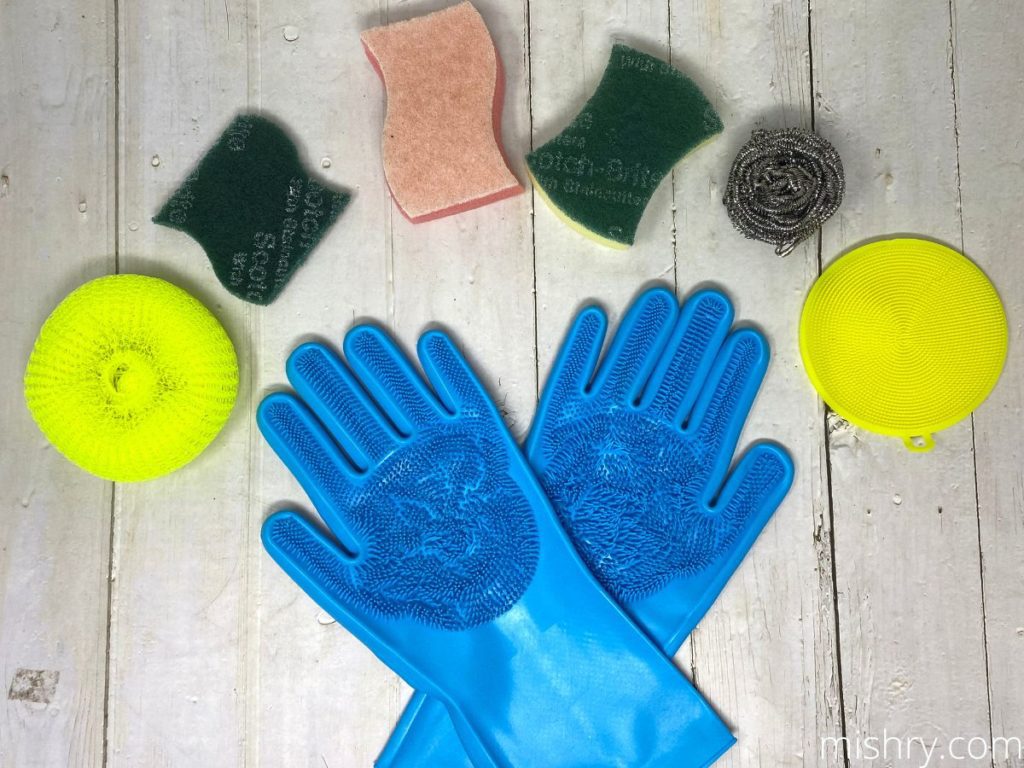An integral part of every home where all the action takes place. No, no! Don’t get us wrong, it’s the kitchen we are talking about. Not your average 9-5, an Indian kitchen sees a double shift perhaps where more than cooking, the cleaning hordes your time.
Keeping in mind the types of materials of utensils found in Indian kitchens, we chose seven types of scrubbers to be put to the test. These were tested on multiple loads of dishes with dishwashing liquids and bars to arrive at an unbiased conclusion over 30 days.
What’s best suited for what and why? Are you ready to learn?
Table of Contents
Types of Scrubbers
Here are the scrubbers we tested in our review.
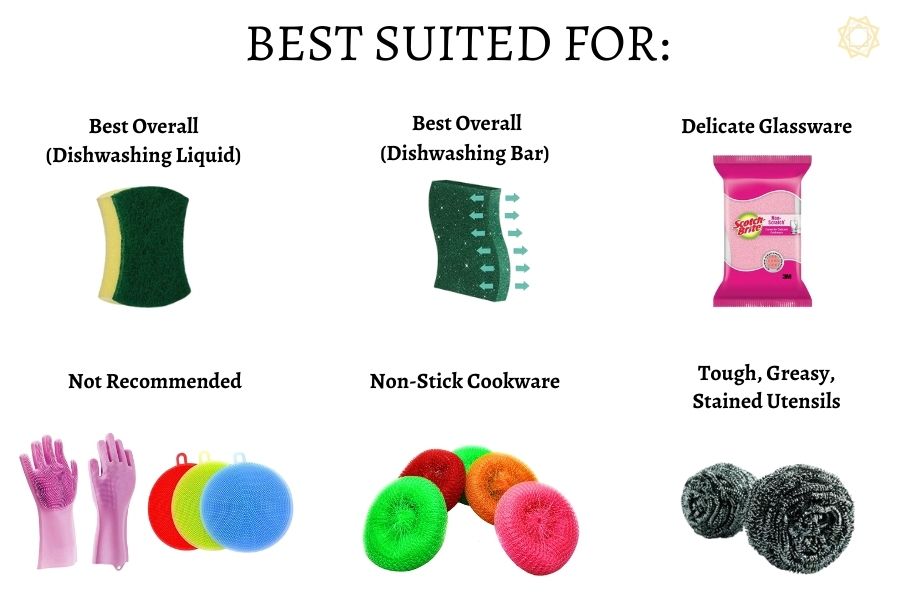
Our Review Factors & Process
How did we produce our scrubbers review?
Let’s break it down – not many Indian homes have a dishwasher. They use a dishwashing bar or liquid and a scrubber. Yes, modern homes may have 2-3 types of scrubbers for different purposes, but more often than not it’s just that one scrubber that you use for everything until specified (example: non-stick)
Some may perform well throughout all categories, while some may be tailored for just 1 specific purpose. We explore it all and give you a lowdown on what’s suited for what and why. The price, packaging, and durability were gauged.
How did we review these seven types of scrubbers? We picked the most commonly used utensil scrubbers in Indian kitchens, some materials that utensils are usually made of, and put them to the test under parameters like convenience, effectiveness, versatility, etc.
All panelists on the review team washed four loads of dishes at their homes that included a minimum of five-six types of materials that are commonly found in Indian homes like stainless steel, aluminum, plastic/melamine, glass, ceramic and bone china. Their experiences have been described here.
The 411 on Dishwashing Scrubbers
How to keep your dishwash scrubbers free of bacteria?
As convenient and as eco-friendly sponges are, they are breeding grounds for bacteria. It is crucial to rinse them after completing a load of dishes, to ensure no food bits are stuck. And the same goes for stainless steel/nylon scrubbers.
Is it time to change your dishwash scrubber?
For sponges, when they look flatter and cannot absorb liquids as efficiently as they could initially, it may be time to replace it. For stainless steel and nylon scrubbers, once the wire/threads start separating and the scrubbers do not clean as well, change them.
7 Different Types of Scrubbers
We discuss the various types of scrubbers used in Indian homes, what they are meant for, and our experience with them in this section.
1. Scrub + Sponge Combination: Best Overall (With liquid detergents)
As the name suggests, there are essentially two sides – a scrub and a sponge. This has a fairly comfortable grip which ensures that your hand (bare skin) is not exposed to the scrub side.
This gets full marks on convenience and efficiency. First things first, we observed that this requires comparatively lesser dishwashing liquid to create a similar amount of foam as other contenders.
Next, the versatility. This can be used to clean an extensive range of utensils like glass, plastic, stainless steel, melamine, bone china, etc. In addition to these, this is also durable.
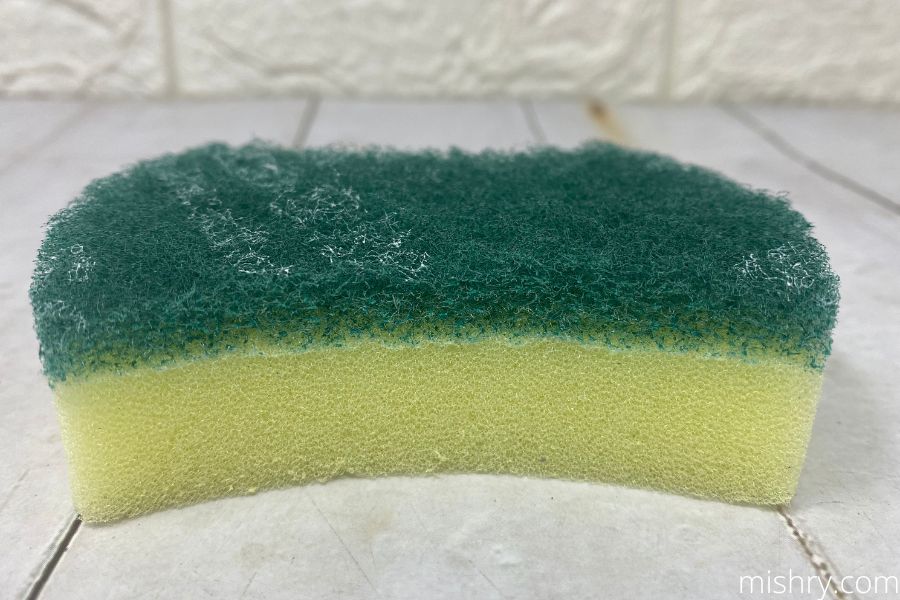
- Durable
- Easy to clean with
- Versatile
- Requires a tiny quantity of washing liquid
- Keeps skin of the hand fairly covered
This would be best used with dishwashing liquid. You can use this across materials like plastic, glass, stainless steel, melamine, bone china, etc.
2. Green Scrub Pad: Best Overall (With detergent bars)
This is a single-layered dishwash scrub. It has a green-coloured abrasive surface. We tested this with a dish washing bar and it cleaned really well. It works across dishes made of stainless steel, aluminium, glass,etc. That said, this is not meant for non-stick surfaces.
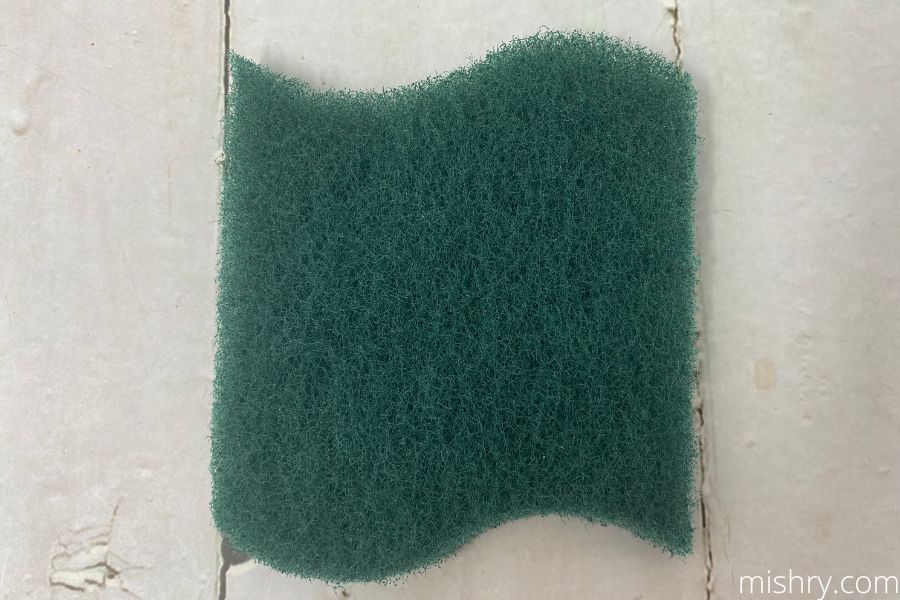
- Versatile
- Best paired with dishwashing soap bars
- Economic
- Fairly durable
This is ideal for everyday use and multiple types of dishes.
3. Nylon Round Scrubber: Best For Non-Stick Cookware
A cleaning tool commonly seen in most Indian homes, these round scrubbers are meant for everyday use. In addition to dishes, these can also be used to scrub floors, bathroom sinks, tiles, among others.
While these nylon scrubbers can be used over stainless steel cookware, this is more adequate for non-stick surfaces. This non-abrasive scrub is not too durable (unfurls in 3-4 uses) but works well on pots, pans with non-stick coating. It will not clean very tough stains, but is appropriate for everyday use.
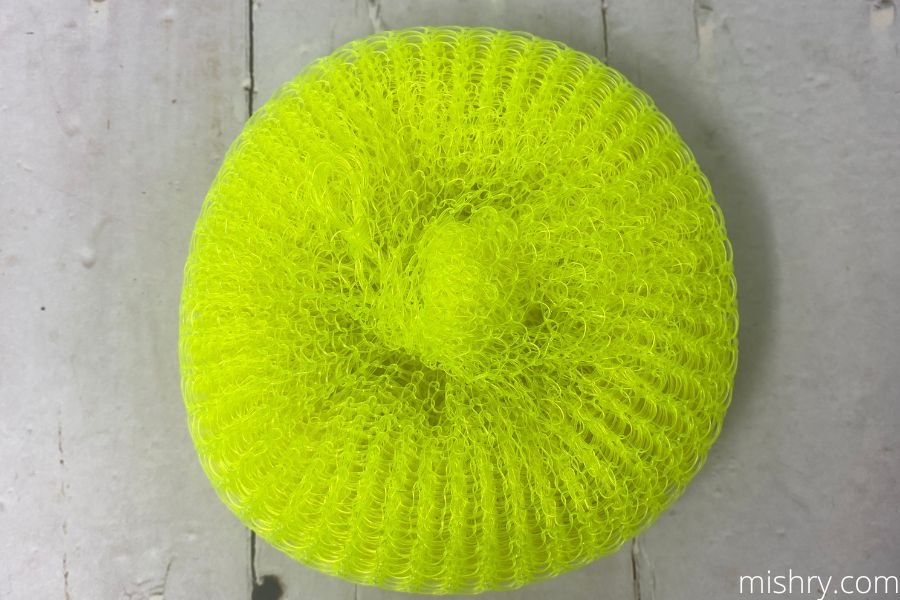
- Meant for everyday use
- For scrubbing vessels, sinks, floors, etc
- Not very durable
- Cannot take out tough stains
These nylon scrubs are best suited for non-stick cookware and even stainless steel dishes, those without tough stains and grease.
4. Stainless Steel Scrubber: For Greasy Utensils
A metal scrubbing pad like this one is your best bet for kadhais after frying, a milk boiler, chai pans used multiple times without washing, pans where you prepared dosas or omlettes.
This goes without saying, but this scrubber worked like magic. All dishes were squeaky clean, there were no stains or spots left behind.
Now this may feel slightly itchy on the palms. And this is not recommended for glass, plastic, or non-stick surfaces as this is extremely abrasive.
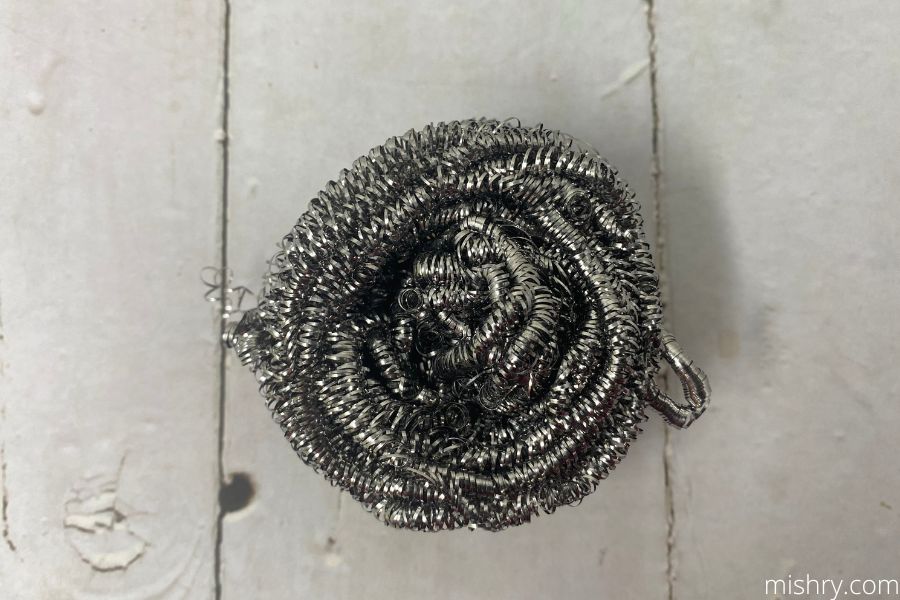
- Works like a dream
- Economic
- Fairly durable
- Tough stains do not stand a chance
Pots, pans, basically all stainless steel, aluminum cookware can be cleaned with this.
5. Scrub Sponge with Light Scrub Pad: For Delicate Glassware
This pink-colored sponge has two sides- one sponge and the other is a non-scratch scrub which is very thin and feels fairly non-abrasive. Like the other scrub-sponge pad, this too does not soak up a lot of dishwashing liquid but creates a substantial amount of lather.
After testing it over a variety of dishes, we think this is ideal for delicate dishes that are made of bone china or glass.
When we tested this over greasy steelware, this was not as effective. It does not really help take out tough stains (those developed while brewing tea, for instance).
That said, we liked the grip. This is quite comfortable to hold.
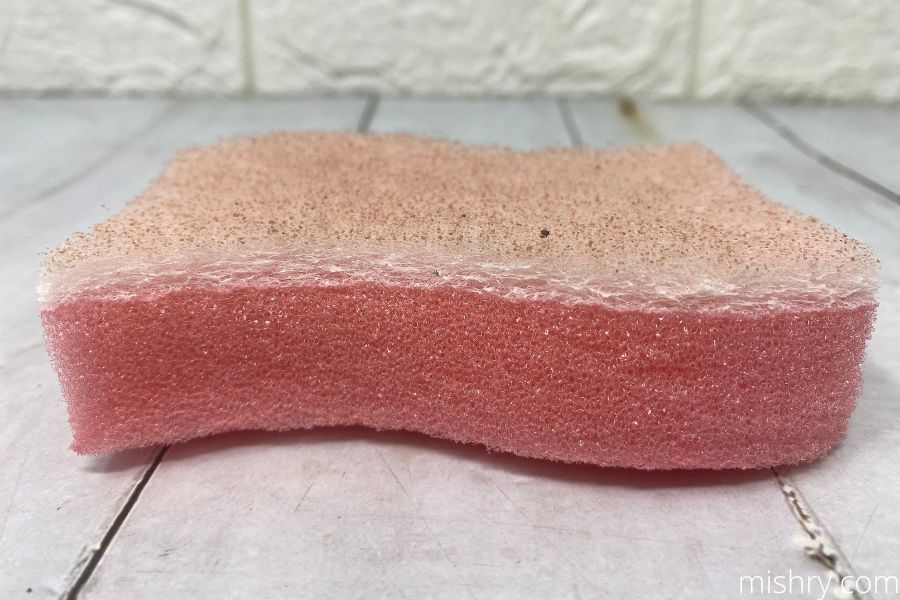
- Needs just a drop or two of dishwashing liquid
- Comfortable to hold and use
- Not meant for tough stains
This is best suited for delicate dishes like bone china, glass, etc.
6. Silicone Dish Washing Gloves: Not Recommended
Right off the bat, this is not something we would recommend if you have a large load of dishes regularly.
These gloves just do not work, neither with dishwashing soap, nor liquid. The bristles are meant to add convenience, but what actually happens is food particles get stuck between them, increasing the mess and time needed to clean. You’ll have to clean the gloves separately too. Moreover, it takes up a lot of product for cleaning barely a dish or two.
That said, the material of these silicone gloves is fairly decent and keeps your hands dry. But it is not something you can use for every load.
When we tried washing a greasy pan, this did not work at all.
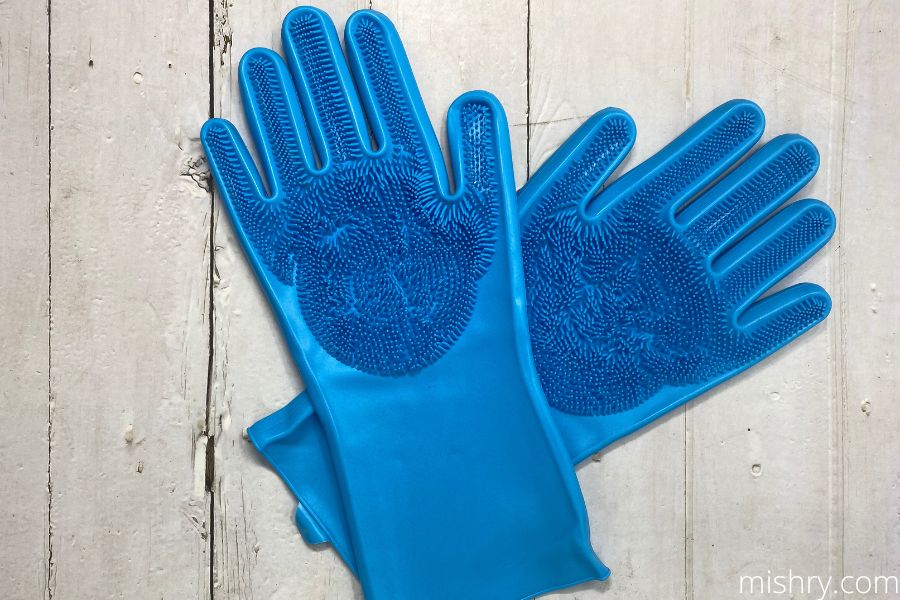
7. Silicone Washing Sponge: Not Recommended
This is fairly identical to the silicone gloves we discussed above, but in a different shape. One, the grip needs a lot of improvement. There is nothing to hold on to, and this slips and slides a lot. This would be fine for plates or glasses, but tough oil stains, stains of masale, spoons or smaller cutlery was a pain to wash with this silicone sponge. Again, food bits would get stuck, making doing the dishes an even more time consuming task.
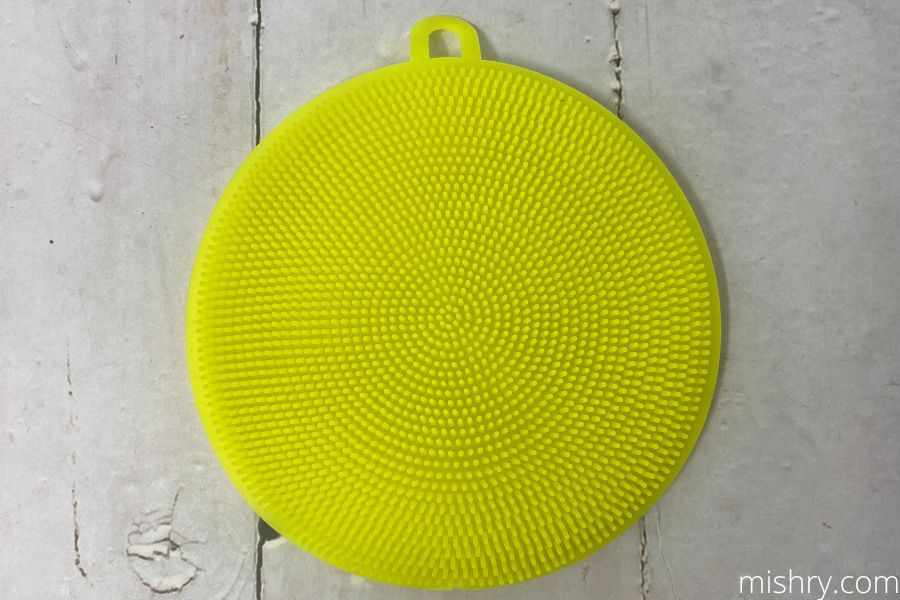
- Poor grip
- Extremely inconvenient
Frequently Asked Questions
Here are some interesting FAQs on types of scrubber.
1. Are these scrubbers heat resistant?
Steel/metal scrubbers are heat resistant. However, we would recommend allowing the cookware to cool down before washing it. This will also enhance its durability.
2. Can these scrubbers be used for washing non-stick utensils?
The round nylon scrubber is best suited for non-stick utensils.
3. How many scrubbers are there in one pack?
This depends on the scrubber you choose. Some may contain one unit in a pack, others have 4-6.
4. Is there any particular soap for this scrubber?
You can use a dishwashing bar or liquid. We suggest using liquids for sponges, and bars for stainless steel and nylon scrubbers.
5.Are these scrubbers good for aluminum utensils?
Yes, the stainless steel scrubber is good for aluminum utensils.
Wrapping Up…
This concludes our types of scrubbers review. While different materials of scrubbers are meant for different surfaces, not all work equally. After testing seven types of scrubbers in our home kitchens, we arrived at the verdict that the scrub + sponge combination is the best scrubber overall.
How many of these do you use regularly?
Our reviews are unbiased and all samples used during the reviews were paid for by us. Read our entire ethics statement here.

